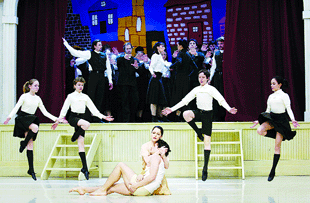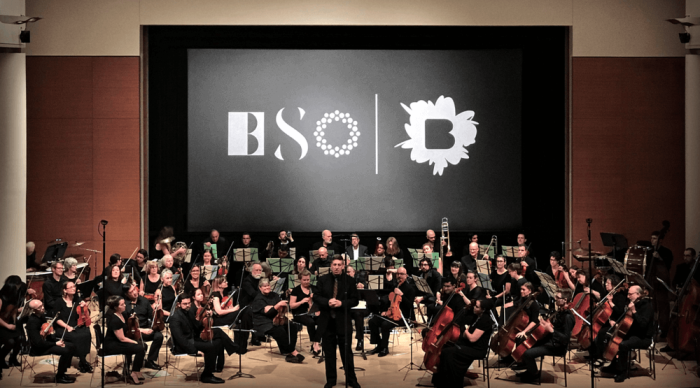National Ballet of Canada successfully integrates “Pied Piper” with a fallen evangelist’s story
“The Contract (The Pied Piper),” 2002, is James Kudelka’s first full-length story ballet. And he admits it is “a narrative ballet with many ambiguities.”
This tragic morality story evinces both the business of art and the plague of AIDS. At the National Ballet of Canada’s captivating performance at the Brooklyn Academy of Music on April 5, we followed the piper. Indeed, we paid the piper.
In the medieval legend told in Robert Browning’s poem “The Pied Piper,” a charismatic exterminator rids the town of rats. When he’s not paid, he lures away the children too.
The ballet begins with kids performing “The Pied Piper” for their parents on a small proscenium upstage in their school auditorium. The set by Michael Levine creates the illusion of a sealed community, with institutional barred windows, fluorescent fixtures and two double exit doors on either side. The fixtures and exit signs double as poetic lighting elements in Kevin Lamotte’s design. The set and lights are intrinsic to the story and are highlights of Kudelka’s stripped-to-essentials choreography. It adds up to a substantial, even lavish experience.
The on-stage audience dances a narrative inspired by the play they’ve just seen. Near 50 performers in several age groups dance in concentric and opposing circles. Kudelka imagined “The Contract” as a wedding of the “Pied Piper” story with that of the late Aimee Semple MacPherson, a glamorous Canadian whose 1926 evangelistic tour of the U.S. ended in a kidnapping hoax she staged to cover up a love affair. Despite this breach of trust, the ministry she launched continues to this day. MacPherson inspired Eva, “The Contract’s” flawed and charismatic faith-healer heroine.
Martine Lamy created the difficult role. She dances lyrically but falls short of expressing either her character’s charisma or flaws, though it is true that audiences perhaps have difficulty accepting either attribute in a woman. Soprano Jennie Such grandly supports Eva with vocals embedded in Michael Torke’s score, which is performed live by the National Ballet Touring Orchestra and collaborating Brooklyn Philharmonic musicians.
Guillaume Côté is Will, a prodigal son who returns home with a contagious disease that effects movement upon his return. At the start, Will dances with energy and abandon, leaping and jumping with great pride and presence. He breaks his contract with fiancé Dot when he falls for Eva, who is on top in their indiscretion. Their lovemaking, during which Côté wears whitish underwear, is only suggested. “The Contract” is for the child in all of us.
Ryan Boorne is the Elder and the Father is Jean-Sebastien Colau, a soloist from Paris Opera Ballet who has been with the Canadian company just three years. The excellent performers chastise Will with kicks à la seconde. He reappears on crutches, imprisoned in his disability. Côté is sweet as a rose and a star performer. The Mother is a superb Xiao Nan Yu.
Refreshingly, there is no point made with the inter-generational cast. It’s part of the story. In the introductory “Pied Piper,” a very small but stout Mayor leads the crowd off the mini-stage after the children disappear with the Pied Piper. This authoritative leader is Carleigh Beverly. The children collaborated on their choreography, working with Kudelka for several months to develop rat sounds and paint scenery. The child-like backdrop for their production-within-the production falls askew, and this distraction seems unnecessary.
The townspeople are the moral force that could emerge in any town. In dark gray-green and white uniforms designed by Denis Lavoie, they step-dance in an upright, folkish manner, a relaxed Riverdance of sorts. Their toes are pointed and the women wear black toe shoes. They exhibit an innocence and blind faith indicative of their human vulnerability. With arms at their sides, their palms are opened toward us with fingers closed as if to accept grace.
With its many layers of complexity and carefully orchestrated elements, this modern ballet adaptation of the “Pied Piper” is a great success. Working within many of the defining traditions of the genre, Kudelka has made a work that speaks to our time in a tongue that rings true.
gaycitynews.com


































